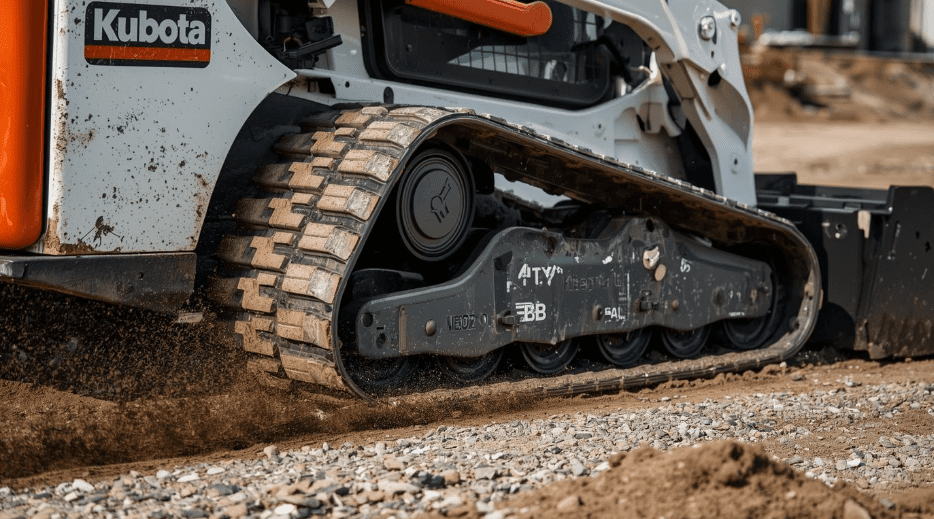The start of a workday can go two ways. Either the machine runs smoothly and steadily, or it feels like you’re fighting it from the very first job. Anyone who’s spent time on a site knows the difference. And often, it comes down to something many people don’t even think about: the tracks.
Tracks don’t look like much at first glance. They sit low, they’re usually covered in mud, and nobody brags about them at the end of the day. But here’s the thing: they control how your skid steer moves, how much fuel it burns, and even how tired you feel after hours behind the controls.
If you’ve ever been stuck in wet ground, sliding on gravel, or chewing through fuel faster than you expected, you already know how much tracks matter.
Why Tracks Make Such a Big Difference
Think of tracks as the handshake between your machine and the ground. A weak grip means wasted effort. A strong grip means you get more done with less struggle.
Good tracks spread the weight of your machine so it doesn’t sink in soft soil. They also give better traction, so you’re not spinning in place or ripping up the ground you’re supposed to protect. And here’s another detail: smoother movement saves fuel. Instead of fighting resistance, the machine rolls forward with less effort.
That’s why the right set of tracks can be the quiet hero of your job site.
Different Types of Tracks
Not all tracks are the same, and this is where things get interesting.
- Rubber tracks: Softer on the ground. Great for landscaping, lawns, and surfaces you don’t want to damage. They also give a smoother ride for the operator.
- Steel tracks: Built for heavy-duty work. They last longer in tough conditions like rocky ground or demolition sites. But they’re harder on softer surfaces.
- Tread patterns: Block-style works better on firm ground, while bar or zig-zag patterns bite into mud and keep you moving.
The choice depends on where you work most. A landscaper doesn’t need the same setup as someone clearing rocky fields.
Why Kubota Skid Steer Tracks Are Worth Attention
If you run a Kubota skid steer, you probably already like its reliability. But here’s the catch: even the best machine won’t perform right without proper tracks. Using Kubota skid steer tracks made for your model means everything fits the way it should. That alone saves you from headaches like uneven wear, wasted fuel, or early breakdowns.
It’s not about chasing fancy upgrades, it’s about making sure your machine and tracks work together like they were designed to.
How Tracks Affect Efficiency
Here’s the part people usually notice on the job: efficiency.
- Fuel: Better traction equals less slipping. Less slipping equals less wasted fuel.
- Time: A machine that glides across mud instead of getting stuck saves hours of back-and-forth.
- Comfort: If the tracks fit the terrain, the operator isn’t getting tossed around all day. Less fatigue means more consistent work.
- Machine health: The right tracks lower stress on the undercarriage and reduce wear-and-tear repairs.
Think about it: one bad set of tracks can turn an 8-hour job into 12 hours of frustration.
Care and Maintenance
Even strong tracks won’t last if you ignore them. A few small habits keep them working longer:
- Check track tension often. Too tight or too loose speeds up wear.
- Clean out mud and stones after a job. Dirt stuck in the tracks shortens their life.
- Watch for cracks or cuts before they spread.
- Rotate usage if you have multiple machines, helps even things out.
It’s not hard, but many operators skip these steps until the damage is done.
Real-World Impact
I’ve seen crews blame weather or soil when the problem was right under their machine. A landscaper lost half a day because his tracks kept tearing up a new lawn. Another operator burned through fuel faster than expected because worn tracks made the skid steer slip constantly.
Once they swapped to the right tracks, the difference was night and day. Jobs finished quicker, fuel bills dropped, and downtime went down.
That’s the quiet power of tracks, you don’t notice them much when they work, but you sure do when they don’t.
Small Choices, Big Results
Tracks don’t look exciting. Nobody posts about them online. But here’s what’s real: choosing the right tracks is one of the simplest ways to boost efficiency on a site. It doesn’t require new machines or big investments, just a smart choice about the parts you’re already using.
And that choice keeps stacking benefits:
- Less wasted fuel
- Less downtime
- Less wear on your machine
- More steady, reliable work
Final Thoughts
Skid steers are built to do tough jobs. But the tracks underneath them decide how well they actually perform. Choosing the right set and keeping them in good shape saves time, money, and energy every single day.
So next time your job feels harder than it should, don’t just blame the ground or the weather. Take a look at the tracks. They might be telling you exactly what’s slowing you down.
______________________________________________________________________________





























